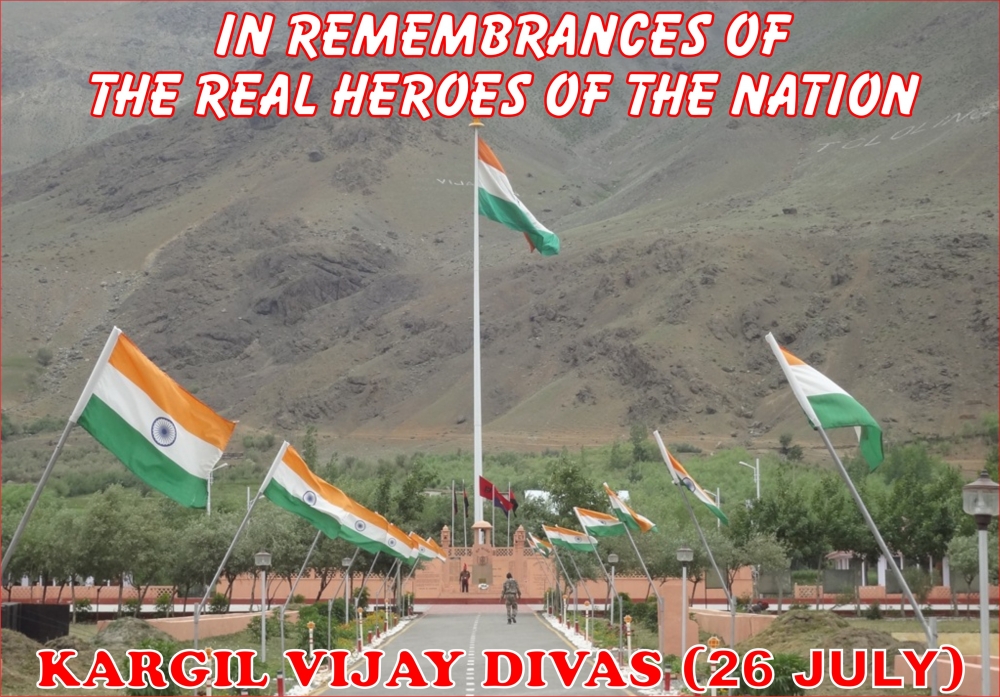_0_o.jpg)
Class IX: Chapter 3 - Drainage (Important Questions for Practice)
Q1. Mention any three features of Indian Drainage System.
Q2. Explain the different drainage patterns formed by the streams.
Q3. What is the importance of lakes? Or How lakes are of great value to human beings? State any six importance. Or Mention some characteristics of lakes.
Q4. Mention a short note on the Indus river system.
Q5. Write a short note on the Brahmputra river system.
Q6. What progress has been made in the Ganga Action Plan?
Q7. What are the major factors responsible for river pollution? Explain.
Q8. Write the main features of the Ganga river system.
Q9. Explain the "National River Conservation Plan" in brief.
Q10. Write a brief note on the peninsular rivers.
Q11. Differentiate between Delta and Estury.
-----x-----X-----x-----
Class VIII: Chapter 3 (Ingredients of Modern Industry) Question & Answer
Very Short Answer Questions
Q1. What is a mineral?
Ans 1: A naturally occurring substance that has a definite chemical composition is known as a mineral.
Q2. Name the leading producers of petroleum in the world.
Ans 2: The leading petroleum producing countries are Iran, Iraq, Saudi Arabia and Qatar. The other major producers are USA, Russia, Venezuela, and Algeria.
Q3. Mention the leading producers of hydel power in the world.
Ans 3: The leading producers of hydel power in the world are Paraguay, Norway, Sweden, USA, Brazil, and China.
Q4. From which two minerals is nuclear energy produced.
Ans 4: Uranium and Thorium are the two minerals from which nuclear energy is produced.
Q5. What are the raw materials used in biogas plant.
Ans 5: Raw material used in biogas plants are the organic waste such as dead plant and animal material, animal dung, human waste, kitchen waste, etc.
Short Answer Questions
Q6. Distinguish between metallic and non-metallic minerals.
Ans 6:

Q7. Distinguish between conventional and non-conventional sources of energy
Ans 7: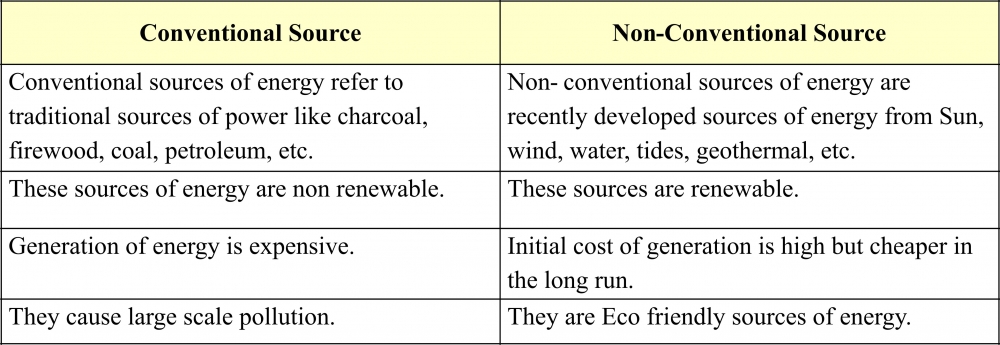
Q8. Distinguish between open cast mining and shaft mining.
Ans 8:

Q9. What are the different ways in which nuclear energy is used in India?
Ans 9: Following are the different ways in which nuclear energy is used in India: -
(a) Electric Power Generation
(b) Nuclear Power Plant Fuel
(c) Making of Nuclear Bombs
(d) Medicine & Scientific Research
(e) Industrial Applications
(f) Space, etc.
Long Answer Questions
Q10. Minerals are very important to us. Why?
Ans 10: Minerals are very important to us because of the following reasons:
(a) Backbone of Industries.
(b) Necessary for the production of all types of tools, machines, implements, etc.
(c) Construction Work.
(d) Maintain health of the people.
(e) Manufacturing of jewellery, utensils, etc.
Minerals play a vital role in human life; these are used in almost every form of life to lead a happy and comfortable life. Minerals are non-renewable-exhaustible and it takes million of years to form. Also, these minerals are unevenly distributed throughout the world. These properties of minerals make them most important to the mankind.
Q11. There is a need for development of non-conventional sources of energy. Give reasons.
Ans 11: The increasing use of fossil fuels is leading to its shortage. It is estimated that if the present rate of consumption continues, the reserves of these fuel will get exhausted. Moreover, their use also causes environmental pollution which leads to global warming. Therefore, there is need for using non-conventional sources such as solar energy, wind energy, tidal energy, geothermal energy, biogas, etc. which are renewable and eco friendly.
Q12. List out four different ways of conserving power resources.
Ans 12: Power or energy resources are minerals which are used as fuels for running machines to produce goods on a large scale.
For e.g. we need power for industry, agriculture, transport, communication and defense. Power resources may be broadly categorized as conventional and non-conventional resources.
Different ways of conserving power resources are: -
(a) We can make use of energy efficient equipments.
(b) Looking for alternative sources of energy.
(c) Use of public transportation system instead of private vehicles.
(d) Switching off electricity when not required.
(e) Making people aware about the importance and conservation of power resources. Etc.
Q13. State the advantages and disadvantages of oil.
Ans 13: Following are the advantages and disadvantages of oil: -

-----x-----X-----x-----
Class IX: Chapter 3 - Drainage (Question & Answers)
Q1. What is meant by a water divide? Give an example.
Ans 1: Any elevated area separates two drainage basins. Such upland is called a water divide. Example: Ambala is located on the water divide between The Indus and The Ganga.
Q2. Which is the largest river basin in India?
Ans 2: The Ganga River Basin is the largest river basin in India
Q3. Where do the rivers Indus and Ganga have their origin?
Ans 3: The Indus river has its origin in Tibet near the Mansarovar Lake where as the Ganga River originates from the Gangotri Glacier in Uttaranchal.
Q4. Name the two headstreams of the Ganga. Where do they meet to form the Ganga?
Ans 4: Bhagirathi and Alaknanda are the two headstreams of river Ganga. Both Bhagirathi and Alaknanda meet at Devaprayag to form the Ganga.
Q5. Why does the Brahmaputra in its Tibetan part have less silt, despite a longer course?
Ans 5: The Brahmaputra river is popularly known as Tsangpo in Tibetan part. Tibet is basically a very cold and dry area, thus, the river carries very small amount of water leading to very less silt content, despite having a large course.
Q6. Which two peninsular rivers flow through trough?
Ans 6: Narmada and Tapi are the two peninsular rivers flowing through the trough.
Q7. State some economic benefits of rivers and lakes.
Ans 7:
Economic benefits of rivers:
1. Rivers have been a source of food since pre-history, almost all the civilizations developed along the river banks.
2. Rivers are also used for irrigation, hydro-power generation.
3. Rivers are used for navigation. They provide the cheapest inland means of transport.
4. Water from the river is the basic natural resource essential for various day-to-day activities of human beings.
5. It is also a rich source of fresh water fish.
Benefits of a Lake:
1. A lake helps in preventing flood by regulating the flow of river.
2. During dry seasons, a lake helps to maintain an even flow of the river.
3. Lakes can also be used for generating hydel power.
4. Tourism development.
5. Maintain aquatic ecosystem.
Q8. Below are given names of a few lakes of India. Group them under two categories – natural and created by human beings.
(a)Wular (b) Dal (c) Nainital (d) Bhimtal (e) Gobind Sagar (f) Loktak (g) Barapani (h) Chilika (i) Sambhar (j) Rana Pratap Sagar (k) Nizam Sagar (l) Pulicat (m) Nagarjuna Sagar (n) Hirakund
Ans 8:
Natural Lakes: Wular, Dal, Nainital, Bhimtal, Loktak, Barapani, Chilika, Sambhar, Pulicat.
Man-made Lakes: Gobind Sagar, Rana Pratap Sagar, Nizam Sagar, Nagarjuna Sagar, Hirakund.
Q9. Discuss the significant difference between the Himalayan and the peninsular rivers.
Ans 9:
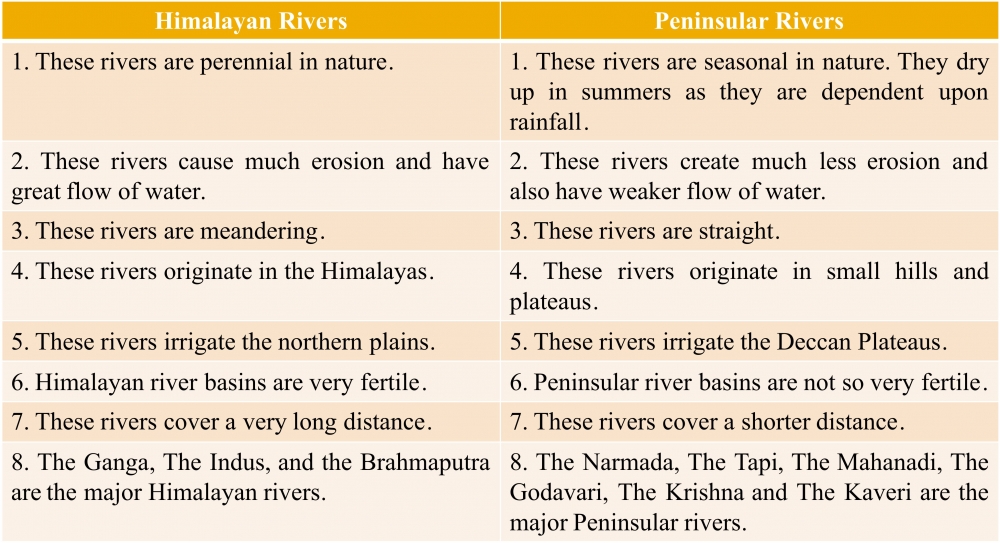
Q10. Compare the east flowing and the west flowing rivers of the peninsular plateau.
Ans 10:
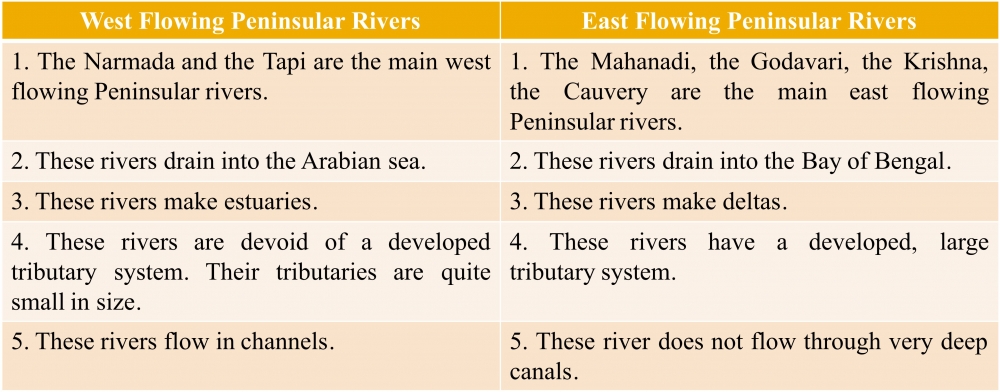
Q11. Why are rivers important for the country's economy?
Ans: Rivers are the major source of water for irrigation and hence are important for a country where farming is still the occupation of the largest portion of population. Many major rivers serve as important channels for transporting goods and people and thus play important role in the supply chain. Many multipurpose projects have been built on most of the major rivers in India.
Following are some of the economic benefits of rivers to a country:
1. Rivers have been a source of food since pre-history, almost all the civilizations developed along the river banks.
2. Rivers are also used for irrigation, hydro-power generation.
3. Rivers are used for navigation. They provide the cheapest inland means of transport.
4. Water from the river is the basic natural resource essential for various day-to-day activities of human beings.
5. It is also a rich source of fresh water fish.
-----x-----X-----x-----
Class VIII: Chapter 3 (Ingredients of Modern Industry)
Objectives and Goals:
- Mineral, Ore.
- Importance of minerals.
- Properties of minerals.
- Classification of minerals (i.e. Metallic, Non-Metallic and Mineral Fuels).
- How the minerals are extracted by Mining, Drilling and Quarrying.
- Distribution of minerals in the world.
- Distribution of minerals in India.
- Need for the conservation of minerals.
- Power resources (i.e. Conventional and Non-Conventional resources).
- Conventional resources of energy (i.e. Firewood, Cattle Dung Cake, Coal, Petroleum, Natural Gas and Electricity (both Hydel and Thermal)).
- Non-Conventional resources (i.e. Solar, Wind, Tidal, Geothermal, Biogas and Atomic Energy).
Earth crust is made up of different metals, which are extracted from minerals. Almost everything is made of minerals.
Q. What are minerals?
Ans: A naturally occurring substance that has a definite chemical composition is known as a mineral.
Minerals are formed in different types of geological environment, under varying conditions. They are created by natural process without any human interference. They can be identified on the basis of their physical properties such as colour, density, hardness and chemical property such as solubility.
IMPORTANCE OF MINERALS
- Backbone of Industries.
- Necessary for the production of all types of tools, machines, implements, etc.
- Construction Work.
- Maintain health of the people.
- Manufacturing of jewellery, utensils, etc.
PROPERTIES OF MINERALS
- Minerals are non-renewable 'exhaustible' resources.
- Minerals takes millions of year to form and are present in impure form.
- Minerals are unevenly distributed through out the world.
TYPES OF MINERALS
Over 2500 minerals have been identified and only a few have been abundantly found. On the basis of composition, minerals are classified as:
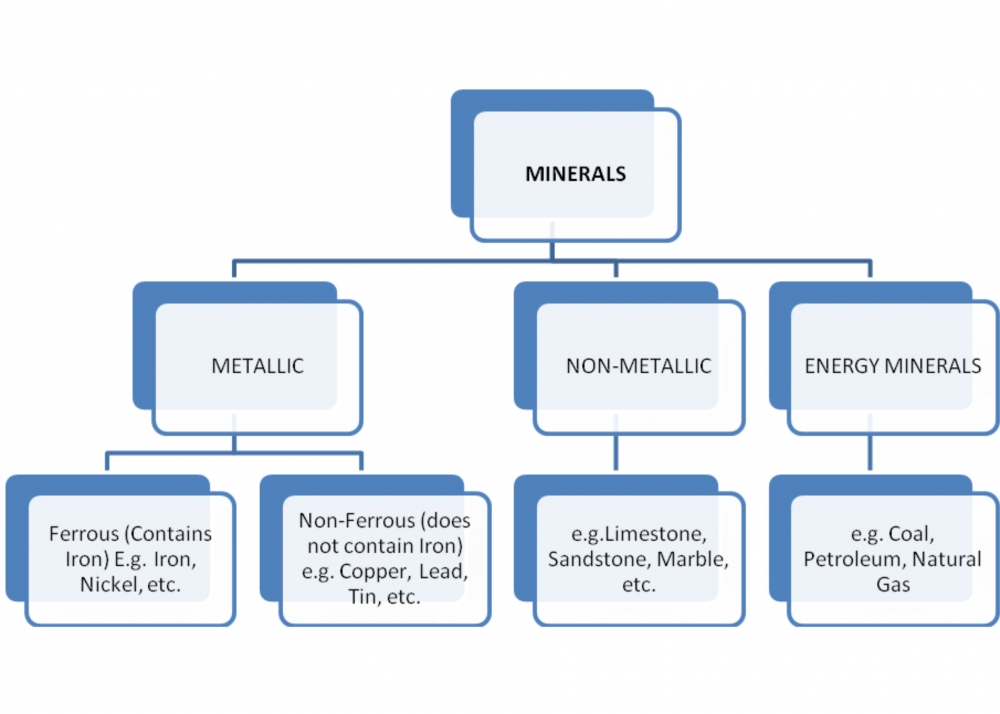
ORE: An ore is a rock deposit that contains enough mineral to make it economically feasible to extract and purify to derive a desired product material. Typical ores and their desired material extracted are: Magnetite - Iron, Bauxite - Aluminium, Limestone - Lime, Sandstone - Silica.
HOW ARE MINERALS EXTRACTED?
Minerals can be extracted by Mining, Drilling and Quarrying.
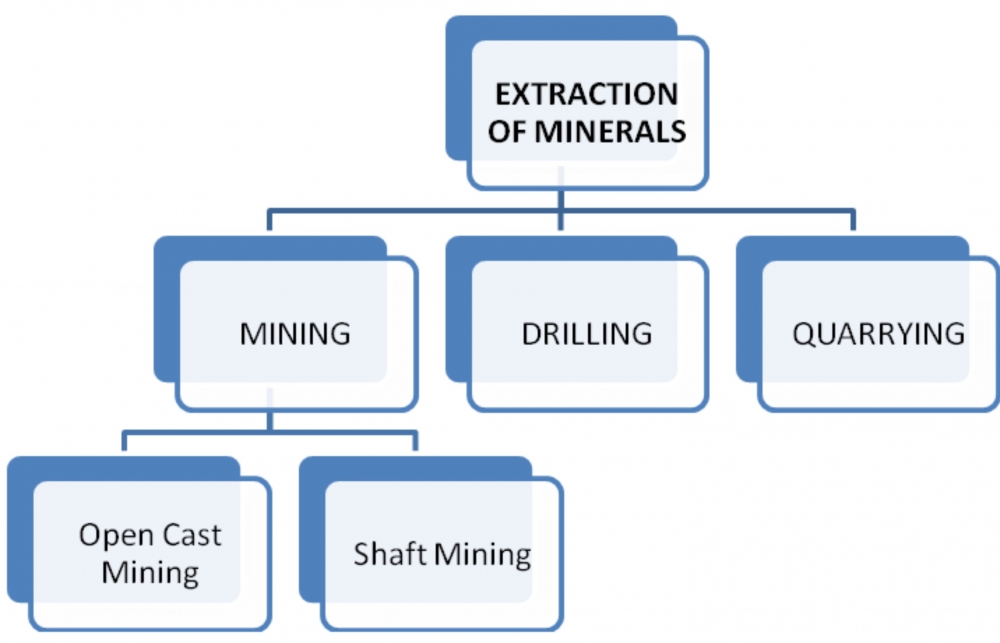
- Mining: The process of taking out minerals from rocks buried under the earth's surface iscalled mining, Drilling and Quarrying.
- Open Cast Mining: Minerals that lie at shallow depths are taken out by removing the surface layer is known as "Open CastMining".
- Shaft Mining: Deep bores, called shafts, have to be made to reach mineral deposits that lie at great depth; this is known as "Shaft Mining".
- Drilling: Petroleum and natural gas occur far below the earth's surface. Deep wells are bored to take them out; this is called "Drilling".
- Quarrying: Minerals that lie near the earth's surface are simply dug out by the process known as "Quarrying".
DISTRIBUTION OF MINERALS
Metallic minerals containing, Iron, Copper, etc. are found in old plateaus which mainly contains igneous and metamorphic rocks. Iron, Nickel, Platinum, etc in South Africa are examples of minerals found in igneous and metamorphic rocks.
Non-metallic minerals like Limestone, Sandstone, Marble, etc. are found in the young fold mountains, which mainly consist of sedimentary rocks. They also contain minerals fuels. Manganese deposits of Georgia, Phosphate beds of Algeria, etc. are the examples of minerals found in Sedimentary rocks.
Asia:
- China and India have large iron ore deposits.
- The continent produces more than half of the world's tin. China, Malaysia and Indonesia are among the world's leading tin producers.
- China also leads in production of lead, antimony and tungsten.
- Asia also has deposits of manganese, bauxite, nickel, zinc and copper.
Europe:
- Europe is the leading producer of iron-ore in the world. The countries with large deposits of iron ore are Russia, Ukraine, Sweden and France.
- Minerals deposits of copper, lead, zinc, manganese and nickel are found in Eastern Europe.
North America:
The mineral deposits in North America are located in three zones:
1. Canadian Shield - Iron ore, Nickel, Gold, Uranium and Copper.
2. Appalachian Region – Coal
3. Western Cordilleras - Copper, Lead, Zinc, Gold and Silver.
South America:
- Brazil is the largest producer of high grade iron-ore in the world.
- Chile and Peru are leading producers of copper.
- Brazil and Bolivia are among the world's largest producers of tin.
- South America also has large deposits of gold, silver, zinc, chromium, manganese, bauxite, mica, platinum, asbestos and diamond.
- Mineral oil is found in Venezuela, Argentina, Chile, Peru and Columbia.
Africa:
- Africa is rich in mineral resources. It is the world's largest producer of diamonds, gold and platinum.
- South Africa, Zimbabwe and Zaire produce a large portion of the world's gold.
- The other minerals found in Africa are copper, iron ore, chromium, uranium, cobalt and bauxite.
- Oil is found in Nigeria, Libya and Angola.
Australia:
- Largest producer of bauxite in the world.
- It is a leading producer of gold, diamond, iron ore, tin and nickel.
- It is also rich in copper, lead, zinc and manganese.
- Kalgoorlie and Coolgardie areas of Western Australia have the largest deposits of gold.
Antarctica:
- Significant size of deposits of coal in the Transantarctic Mountains and iron near the Prince Charles Mountains of East Antarctica is forecasted.
- Iron ore, gold, silver and oil are also present in commercial quantities.
DISTRIBUTION IN INDIA
Iron:
- India has deposits of high grade iron ore.
- The mineral is found mainly in Jharkhand, Orissa, Chhattisgarh, Madhya Pradesh, Goa, Maharashtra and Karnataka.
- All other industries depend on iron & steel industry.
- High grade iron is called 'Magnetite'; other variety is called 'Hematite'
Bauxite:
- Aluminum is obtained from bauxite.
- Major bauxite producing areas are Jharkhand, Orissa, Chhattisgarh, Madhya Pradesh, Gujarat, Maharashtra and Tamil Nadu.
- Aluminum has strength of iron, but it is extremely light.
Mica:
- Mica deposits mainly occur in Jharkhand, Bihar, Andhra Pradesh and Rajasthan. India is the largest producer and exporter of mica in the world.
- Mica is made up of series of plates or leaves.
- It is used in Electric & Electronic industries.
- Mica can be of black, green, red, yellow or brown is colour.
Copper
- It is a good conductor of heat.
- It is mainly produced in Rajasthan, Madhya Pradesh, Jharkhand, Karnataka and Andhra Pradesh.
Manganese:
- Mainly used in manufacturing of steel, bleaching powder, insecticides and paints.
- India's manganese deposits lie in Maharashtra, Madhya Pradesh, Chhattisgarh, Orissa, Karnataka and Andhra Pradesh.
Limestone:
- Basic raw material for the cement industry.
- Major limestone producing states in India are Bihar, Jharkhand, Orissa, Madhya Pradesh, Chhattisgarh, Rajasthan, Gujarat and Tamil Nadu.
Salt:
- Obtained from sea, lakes and rocks.
- India is one of the world's leading producers and exporter of salt.
Gold:
- Kolar in Karnataka has deposits of gold in India. These mines are among the deepest in the world which makes mining of this ore a very expensive process.
Silicon:
- It is used in computer industry and is obtained from quartz.
CONSERVATION OF MINERALS
- Minerals are a non-renewable resource.
- It takes thousands of years for the formation and concentration of minerals.
- The rate of formation is much smaller than the rate at which the humans consume these minerals. It is necessary to reduce wastage in the process of mining.
- Recycling of metals is another way in which the mineral resources can be conserved.
POWER RESOURCES
Power or energy plays a vital role in our lives. We also need power for industry, agriculture, transport, communication and defense. Power resources may be broadly categorized as conventional and non-conventional resources.
Conventional:
- Firewood, cattle dung cake, coal, petroleum, natural gas and electricity (both hydel and thermal).
- It has been used for a very long time.
Non-Conventional:
- Solar, wind, tidal, geothermal, biogas and atomic energy.
- They are new sources of energy.
CONVENTIONAL SOURCES OF ENERGY
Firewood:
- It is widely used for cooking and heating.
- In our country more than fifty per cent of the energy used by villagers comes from fire wood.

FOSSIL FUELS
Remains of plants and animals which were buried under the earth for millions of years got converted by the heat and pressure into fossil fuels. Fossil fuel such as coal, petroleum and natural gas are the main sources of conventional energy.
Coal:
- Most abundantly found fossil fuel.
- It is used as a domestic fuel, in industries such as iron and steel, steam engines and to generate electricity. Electricity from coal is called thermal power.
- The leading coal producers of the world are China, USA, Germany, Russia, South Africa and France.
- The coal producing areas of India are Raniganj, Jharia, Dhanbad and Bokaro in Jharkhand.

Petroleum:
- It is found between the layers of rocks and is drilled from oil fields located in off shore and coastal areas.
- This is then sent to refineries which process the crude oil and produce a variety of products like diesel, petrol, kerosene, wax, plastics and lubricants.
- Petroleum and its derivatives are called Black Gold as they are very valuable.
- The chief petroleum producing countries are Iran, Iraq, Saudi Arabia and Qatar. The other major producers are USA, Russia, Venezuela, and Algeria.
- The leading producers in India are Digboi in Assam, Bombay High in Mumbai, Ankleshwar in Gujarat and the deltas of Krishna and Godavari rivers.

Natural Gas:
- Natural gas is found with petroleum deposits and is released when crude oil is brought to the surface.
- It can be used as a domestic and industrial fuel.
- Russia, Norway, UK and the Netherlands are the major producers of natural gas.
- In India Jaisalmer, Krishna Godavari delta, Tripura and some areas off shore in Mumbai have natural gas resources.

Hydel Power: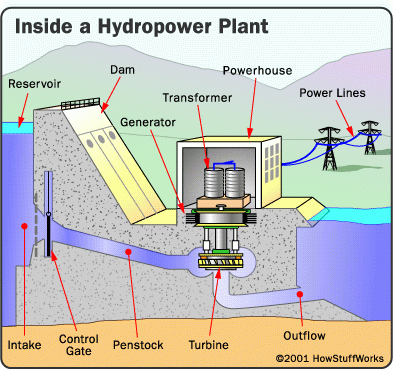
- Rain water or river water stored in dams is made to fall from heights. The falling water flows through pipes inside the dam over turbine blades placed at the bottom of the dam. The moving blades then turn the generator to produce electricity. This is called hydro electricity.
- The water discharged after the generation of electricity is used for irrigation.
- One fourth of the world's electricity is produced by hydel power.
- The leading producers of hydel power in the world are Paraguay, Norway, Brazil, and China.
- Some important hydel power stations in India are Bhakra Nangal, Gandhi Sagar, Nagarjunsagar and Damodar valley projects.

NON-CONVENTIONAL SOURCES OF ENERGY
Solar Energy:
- Solar energy trapped from the sun can be used in solar cells to produce electricity. Many of these cells are joined into solar panels to generate power for heating and lighting purpose.
- The technology of utilizing solar energy benefits a lot of tropical countries that are blessed with abundant sun shine.
- Solar energy is also used in solar heaters, solar cookers, solar dryers besides being used for community lighting and traffic signals.
- The largest solar plant of India is located at Madhapur near Bhuj (Gujarat).

Wind Energy:
- Wind is an inexhaustible source of energy.
- In modern time wind mills, the high speed winds rotate the wind mill which is connected to a generator to produce electricity.
- Wind farms having clusters of such wind mills are located in coastal regions and in mountain passes where strong and steady winds blow.
- Windfarms are found in Netherlands, Germany, Denmark, UK, USA and Spain are noted for their wind energy production.
- In India, the largest windfarm cluster is located in Tamil Nadu from Nagercoil to Madurai.

Nuclear Power:
- Nuclear power is obtained from energy stored in the nuclei of atoms of naturally occurring radio active elements like Uranium and Thorium.
- These fuels undergo nuclear fission in nuclear reactors and emit power.
- The greatest producers of nuclear power are USA and Europe.
- In India Rajasthan and Jharkhand have large deposits of Uranium.
- Thorium is found in large quantities in the Monozite sands of Kerala.
- The nuclear power stations in India are located in Kalpakkam in Tamilnadu, Tarapur in Maharashtra, Rawatbhata in Rajasthan, Kakrapara in Gujarat, Narora in Uttar Pradesh and Kaiga in Karnataka.

Geothermal Energy: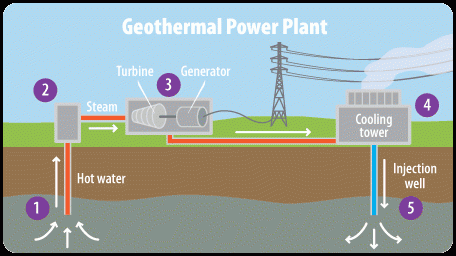
- Heat energy obtained from the earth is called geothermal energy.
- The temperature in the interior of the earth rises steadily as we go deeper. Sometimes this heat energy may surface itself in the form of hot springs.
- This heat energy can be used to generate power.
- Geothermal energy in the form of hot springs has been used for cooking, heating and bathing, etc.
- USA has the world's largest geothermal power plants followed by New Zealand, Iceland, Philippines and Central America.
- In India, geothermal plants are located in Manikaran in Himachal Pradesh and Puga Valley in Ladakh.

Tidal Energy: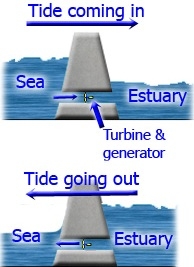
- Energy generated from tides is called tidal energy.
- Tidal energy can be obtained by building dams at narrow openings of the sea. During high tide the energy of the tides is used to turn the turbine installed in the dam to produce electricity.
- Russia, France and the Gulf of Kachchh in India have huge tidal mill farms.

Biogas:
- Organic waste such as dead plant and animal material, animal dung and kitchen waste can be converted into a gaseous fuel called biogas.
- The organic waste is decomposed by bacteria in biogas digesters to emit biogas which is essentially a mixture of methane and carbon dioxide.
- Biogas is an excellent fuel for cooking and lighting and produces huge amount of organic manure.

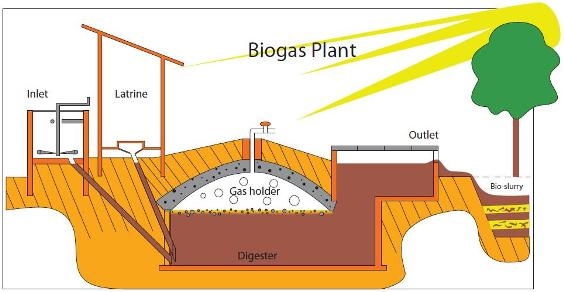
-----x-----X-----x-----
Vijay Divas (26 July)
